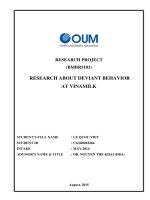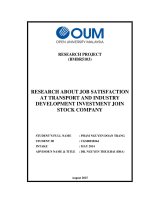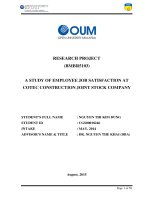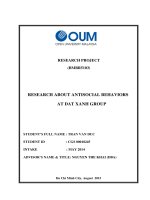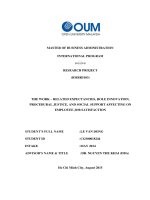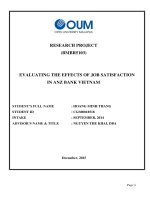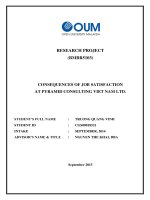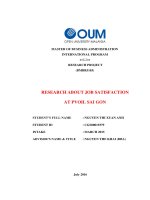Research about job satisfaction at coca cola vietnam
Bạn đang xem bản rút gọn của tài liệu. Xem và tải ngay bản đầy đủ của tài liệu tại đây (626.46 KB, 54 trang )
MASTER OF BUSINESS ADMINISTRATION
INTERNATIONAL PROGRAM
RESEARCH PROJECT
(BMBR5103)
THE WORK – RELATED EXPECTANCIES, ROLE INNOVATION,
PROCEDURAL JUSTICE, AND SOCIAL SUPPORT AFFECTING ON
EMPLOYEE JOB SATISFACTION
STUDENT’S FULL NAME
:LE VAN DONG
STUDENT ID
:CGS00018244
INTAKE
:MAY 2014
ADVISOR’S NAME & TITLE
:DR. NGUYEN THE KHAI (DBA)
Ho Chi Minh City, August 2015
Advisor’s Assessment
-------------------------------------------------------------------------------------------------------------------------------------------------------------------------------------------------------------------------------------------------------------------------------------------------------------------------------------------------------------------------------------------------------------------------------------------------------------------------------------------------------------------------------------------------------------------------------------------------------------------------------------------------------------------------------------------------------------------------------------------------------------------------------------------------------------------------------------------------------------------------------------------------------------------------------------------------------------------------------------------------------------------------------------------------------------------------------------------------------------------------------------------------------------------------------------------------------------------------------------------------------------------------------------------------------------------------------------------------------------------------------------------------------------------------------------------------------------------------------------------------------------------------------------------------------------------------------------------------------------------------
Advisor’s signature
Page 1 of 53
ACKNOWLEDGEMENTS
I wish to acknowledge the help of several individuals because without their
assistance, guidance, and understanding this research would not have been possible.
Firstly, I am very grateful to my advisor DBA. Khai Nguyen. His patience, time,
and commitment, in addition to his constant encouragement, effort, constructive
comments,
support,
and
individualized attention
were
a major source of
inspiration. Thank you for trusting in me. The other members of my committee
were also great assets.
I wish to give my sincerest and deepest gratitude to my family and all of
my sweet friends for their encouragement, and great support.
Page 2 of 53
Contents
ABSTRACT ...................................................................................................................................... 6
Chapter 1: INTRODUCTION ........................................................................................................ 7
Introduction of COCA-COLA .................................................................................................... 7
Company background ................................................................................................................. 7
Vision and mission ....................................................................................................................... 8
Vision ............................................................................................................................................. 8
Mission .......................................................................................................................................... 9
Current strategic objectives ...................................................................................................... 11
Organizational structure ........................................................................................................... 12
Leadership .................................................................................................................................. 12
Culture ........................................................................................................................................ 13
Research problem statement of the study ................................................................................ 15
Contribute of the study .............................................................................................................. 15
Statement of purpose and the Question of the study .............................................................. 16
Chapter 2: LITTERATURE REVIEW ....................................................................................... 16
Job satisfaction ........................................................................................................................... 17
Work – Related Expectancies ................................................................................................... 21
Role innovation........................................................................................................................... 22
Procedural Justice ...................................................................................................................... 23
Social support ............................................................................................................................. 24
The relationship between work – related expectancies and job satisfaction ........................ 27
The relationship between role innovation and job satisfaction.............................................. 27
The relationship between procedural justice and job satisfaction......................................... 28
The relationship between social support and job satisfaction................................................ 29
Chapter 3: RESEARCH MODEL AND HYPOTHESES .......................................................... 30
Research model .......................................................................................................................... 31
Dependent Variables:............................................................................................................. 31
Independent Variables: ......................................................................................................... 31
Constructs ............................................................................................................................... 31
Data Colection ............................................................................................................................ 32
Procedure for Data Collection and Analyze ............................................................................ 32
Measures of Constructs ............................................................................................................. 33
Page 3 of 53
Job satisfaction questionnaire ............................................................................................... 33
Work – related expectancies ................................................................................................... 33
Role innovation ....................................................................................................................... 34
Procedural justice.................................................................................................................... 35
Social support .......................................................................................................................... 36
Chapter 4 : RESULTS ................................................................................................................... 38
Cronbach‘s Alpha ........................................................................................................................ 38
Descriptive statistics .................................................................................................................... 39
Hypotheses testing ....................................................................................................................... 39
Hypothesis (H1) ....................................................................................................................... 40
Hypothesis (H2) ...................................................................................................................... 41
Hypothesis (H3) ...................................................................................................................... 41
Hypothesis (H4) ...................................................................................................................... 41
Chapter 5: CONCLUSIONS ........................................................................................................ 42
Discussion .................................................................................................................................... 42
Contributions................................................................................................................................ 43
Limitations ................................................................................................................................... 44
APPENDIX A ................................................................................................................................. 47
Page 4 of 53
LIST OF FIGURE AND TABLE
Figure 1 Logo of Coca Cola ............................................................................ 7
Figure 2 Coca Cola can ................................................................................... 11
Figure 3: Organizational structure .................................................................. 12
Figure 4 Mr. Vamsi Mohan - General Director of Coca-Cola Vietnam and
Cambodia ......................................................................................................... 12
Figure 5 Coca Cola‘s values ........................................................................... 13
Figure 6: Hypothesized Research Model ....................................................... 31
Table 1: Cronbach's Alpha- Internal consistency ........................................... 38
Table 2: Cronbach‘s Alpha of Construct ......................................................... 38
Table 3: Descriptive statistics .......................................................................... 39
Table 4: R Square ........................................................................................... 40
Table 5: Coefficients value of the model ........................................................ 40
Page 5 of 53
ABSTRACT
This study tested that the impact of work – related expectancies, role
innovation, procedural justice, and social support on employee job satisfaction.
I hypothesized the positive relationship related to job satisfaction of employee. The
result of 286 data was collected form managerial and non- managerial employees
of COCA-COLA Corporation in Viet Nam. Result: The results supported the
hypothesis that work – related expectancies, procedural justice have significant
relationship with employee‘s job satisfaction. Conclusion: The findings in this
study would help managers to formulate strategies that involved work factors such
as distributive and procedural justice to improve the management of human
resource development. These strategies would help in influencing positive
behaviors among employees, and hence achieve effectiveness and high productivity
in the organization. Therefore, it was worth the effort for the organization to train
and educate their managers on the impact of perceptions of organizational justice on
the motivation and commitment of their employees.
Keywords: Job satisfaction, work – related expectancies, role innovation,
procedural justice, social support.
Page 6 of 53
Chapter 1: INTRODUCTION
Introduction of COCA-COLA
As you know, Coca-Cola is one of the most favorable drinks all over the
world, its own brand-name costs about $80 billion. In 1960, Coca-Cola was the first
time introduced in Vietnam. After that, Coca-Cola Indochina Pte Company was
established officially in Vietnam on August 1995.
Company background
Figure 1 Logo of Coca Cola
The Coca-Cola Company is headquartered in Atlanta, Georgia in United
States. Coca-Cola was invented in 1886 by John Pemberton who was Georgia
pharmacist. Muhtar Kent who was born in 1952 in New York, United States is
currently the Chairman and Chief Executive Officer (CEO) and stick with the
operation of The Coca-Cola Company.
The Coca-Cola Company establishes its firm in the worldwide areas and
currently sells its products to over 200 countries. The firm operations are divided
into several geographies which are Eurasia and Africa, Europe, Latin American,
North American and Pacific. The Coca-Cola Company is a beverage company
which produces more than 3000 beverage products. The Coca-Cola Company is
also a manufacturer, distributor, bottler, and marketer of non-alcoholic beverage
concentrates and syrups. Under the implementation of the Coca-Cola system, the
Coca-Cola Company has to cooperate with over 300 bottling partners worldwide.
The company produces the products such as waters, juices and juice drinks, teas,
coffees, sports drinks and energy drinks. The company has four of the world‘s top
Page 7 of 53
five nonalcoholic sparkling beverage brands which are Coca-Cola, Diet Coke,
Sprite and Fanta.
In 1960, Coca cola was the first time introduced in Vietnam. After that,
Coca-Cola Indochina Pte Company was established officially in Vietnam on
August 1995. Since then, Coca-Cola has some locations in Vietnam, which were
united as one Beverage Company called Coca-Cola Vietnam with the head office
located in Thu Duc District, Ho Chi Minh City.
Vision and mission
In the strategic management model, clear vision and mission statements are
very important for alternative strategies to be formulated and implemented. A clear
business vision will help the firm build a comprehensive mission statement and a
clear mission is needed before alternative strategies can be formulated and
implemented. So developing a good vision and mission is essential for any firm and
a big company like Coca Cola is not an exception.
Vision
The vision 2020 is a great direction for Coca cola‘s development in beverage
industry. The company is aware of what they need to do in present and in the
future. They concern not only in their profit or productivity but also in people. This
can support them to develop in both quantity and quality.
People: Be a great place to work where people are inspired to be the
best they can. Attract, engage and retain the best talent by knowledge,
inspiration of passion, recruiting, developing and advancing women,
achieve true diversity.
Portfolio: Bring to the world a portfolio of quality beverage brands that
anticipate and satisfy people's desires and needs.
Partners: Nurture a winning network of customers and suppliers,
together we create mutual, enduring value.
Planet: Have responsibility to society by helping build and support
sustainable communities.
Page 8 of 53
Profit: Maximize long-term return to shareowners while being mindful
of our overall responsibilities.
Productivity: Be a highly effective, lean and fast-moving organization;
manage people, time and money for the greatest effectiveness.
Mission
Cola need a clear mission before setting up alternative strategies to be
formulated and implemented. Mission will be analyzed based on nine main factors
which are customers, products, markets, technology, concern for survival growthprofitability, philosophy, self-concept, concern for public image and employee.
―Our Roadmap starts with our mission, which is enduring. It declares our
purpose as a company and serves as the standard against which we weigh our
actions and decisions.‖
To refresh the world...
To inspire moments of optimism and happiness...
To create value and make a difference. ―
Above are three main factors that is inspiration for doing with Coke‘s mission from
current to the future, at least to 2020 with company‘s expectation of serving people
best.
Customers: For Coca cola, customers are the ones who need to be
appreciated and offered the most quality products and the best of serving
from Coca cola. The company serves the diversity of customers including
their agencies, distributors and all the Coca cola users in a large scale.
Products: Coca cola towards to bring the safety and quality products which
ensure about the natural alcohol levels, colorings and carbon dioxide
level…Diversity in kind of drinks is also a criteria of Coca cola products.
Market: Expand the market of Coca Cola; gain the aimed point of sales.
Coca cola expand their consumption investment. They increase to participate
and serve in local, provide more outlets and to many specific shoppers.
Page 9 of 53
Public image: Mission of Coca cola is not only a leader in offering the best
drinks, but also a global leader in environment protection, in packaging and
producing and disposing system.
Philosophy: Coca-Cola Enterprises provides products and services meeting
the beverage and business needs of thousands of retail customers. Opening
dialogue and ongoing relationships, Coca cola work to build mutual
understanding and trust to pursuit the goals. Customer relationships are
central to Coca cola‘s effort and philosophy.
Technology: The company displays their direction of technology in the
vision report as the purpose needed to achieve such as using the advanced
and modern technology which contributes to increase the productivity.
Self-concept that Coca cola is the firm which refreshes the world with the
delicious and fresh drinks and brings people on over the world the moments
and feelings of optimism and happiness, creates the difference to make
customers remember and appreciate Coca cola‘s values.
Concerns for employees: increasing people‘s system knowledge and crosssystem movement, inspiring employees to be passionate, recruiting,
developing and advancing women, making better conditions for all
employees to devote their creative and qualification for great drinks.
Concerns for growth, profit, survival: This element is not also demanded in
the mission but generally the company displays what to do in a detail report.
Coca cola want to operate the lowest cost manufacturing and logistics in
every market while maintain the quality standards; also use the size and
expertise for creating the economic scale.
There are some important components that should be considered and put in
the mission such as technology, philosophy and its concern for survival growth and
profitability. Company should give more details about mission which would show
the customers and employers know what Coca Cola‘s aim, targets and big picture
about it in future.
Page 10 of 53
Current strategic objectives
Coca-Cola‘s objective is maintaining a trusted local presence in every
community its serve. Coca Cola is constantly looking ahead to anticipate what
communities may need and gathering resources to support them. To carry out this
objective, they‘ve devised a strategy to build out on fundamental strengths in
marketing and innovation by increasing efficiency and effectiveness in interactions
and generating new energy through core brands that focus on health and wellness.
Their tactic is to increase their annual marketing budget, launch many new
products, and developed a model to help our retail customers maximize their sales.
Figure 2 Coca Cola can
Page 11 of 53
Organizational structure
Figure 3: Organizational structure
Leadership
Mr. Vamsi Mohan was born and brought
up in India. During the nearly 20-year
career at Coca-Cola, he had played many
important roles before becoming general
director of Coca-Cola Vietnam and
Cambodia. He holds a Bachelor of
Technology degree in Electronics and
Communications
Engineering
from
Figure 4 Mr. Vamsi Mohan - General
Jawaharlal Nehru Technological University,
Director of Coca-Cola Vietnam and
Hyderabad and a post-graduate Diploma in
Cambodia
Management from the Indian Institute of
Management, Calcutta.
Page 12 of 53
Vamsi Mohan and other managers of Coca Cola have recognized that
Vietnamese industry is extremely potential. Some surveys have shown that the
demand of this product in Vietnamese market is very high. A lot of people,
especially young people are very keen on Coca Cola drinks. Therefore, Vamsi
Mohan and his team successfully reintroduced and launched a number of Company
brands and established Coca Cola‘s commercial operations across the country,
laying a strong foundation for their business in this market.
Culture
Coca-Cola exists to benefit and refresh everyone it touches. Its beliefs stem
from global ideals grounded in local insights and influences. Coca-Cola takes
responsibility for providing a wide variety of quality beverages so that parents,
youth, children and all consumers will have enjoyable refreshment choices. Today,
these choices include soft drinks, juices, waters, sports drinks, tea and coffee
products and others - with more options to come in the future.
Live Our Values. It serves as a compass for Coca cola company‘s actions
and describes how they behave in the world.
Figure 5 Coca Cola’s values
Page 13 of 53
Coca cola focuses on the Market, especially on needs of consumers,
customers and franchise partners. Getting out into the market, listen and
observe helping them to learn and understand more their business
environment. They become a world view focusing on execution in the
marketplace every day. However, the curiosity is never satiable because it is
the factor stimulating the learning and development.
Work Smart is one of the most important core values. They always act with
urgency, remain responsive to change, have the courage to change course
when needed, remain constructively discontent, work efficiently. These are
the smart way to work that brings more success to Coke in the future.
Coca cola act like an owner by understanding needs and what to do well for
themselves and their customers. An owner must have a smart system to
operate and must focus on building their values, positioning in the beverage
market. The action of rewarding for people who take risks and find better way
to solve problem is a good solution to increase and develop the loyalty.
Learning form the outcomes is also a qualification of an owner.
Be the Brand Coca cola inspire creativity, passion, optimism and fun as their
brand.
The true ‗secret formula‘ of Coca-Cola is its highly talented and motivated
associates. There is a statement spoken by a manager: ―We are a high
performance team in a happiness factory with happy energy who takes
ownership and pride in refreshing and inspiring the world around us. We
leverage our rich individuality to grow the collective excellence‖.
Employee engagement at every level is the key to being the employer of
choice, where people create extraordinary results every day. Not only does
Coca Cola refresh the world through our brands, it also inspires each
employee with optimism and ignites the passion within every individual. Coca
Cola ensures that every single employee at Coca-Cola Singapore is equipped
Page 14 of 53
with adequate knowledge and opportunities to grow. An openness in
communication is what drives the dynamism here.
Research problem statement of the study
The intense competition of the beverage industry in the Vietnamese market.
Coca-Cola is one of the big companies in the world and Vietnam. Nowadays, many
companies with high potential resources receive the opportunities in this field. So
lot of competitors try to compete to gain the market share. They aren‘t only using
the finance resource but also try to attract the people from the other competitors.
The purpose of Coca-Cola in market economy is to achieve the most
effective performance in long term. Performance of the enterprise is the correlative
result comparing the profits from the business activities of enterprises with the
resources used to archive those profits. The enterprise performance is decided by
many factors, in which human resources quality is the most important.
Human
resources
have an important role affect the survival and
development of any organizations and job satisfaction has been an important point
for organizational . How does the organization create employee job satisfaction?
This question is what heads of an organization are interested in. Therefore, the
relationship between employee job satisfaction and organization commitment are
necessary and should be focused. In fact, a lot of organization didn't satisfy the
employee job satisfaction related promotion, salary so on.
Human resources management is at the core development and execution of
COCA-COLA. The board of directors of COCA-COLA knows thoroughly
innovation, leadership, cooperation and loyalty play a vital role in COCA-COLA‘s
success. COCA-COLA has invested heavily in people to make it become an
advantage of the company.
Contribute of the study
This study will be conducted from either managerial employees or nonmanagerial employees to exclude the bias of self-report. The opinion of employees
Page 15 of 53
in Coca-Cola about the impact of work – related expectancies, role innovation,
procedural justice, and social support on Coca-Cola Corporation‘s employee job
satisfaction will be collected to see what the being implemented side evaluates the
company HRM policies.
The study provided a general view to HMR about the satisfaction of their
employees. They understand the needs and how the employees feel about the
current at Coca-Cola. Thereby the board of management make a policy and set out
strategy to enhance satisfaction of employees and contribute on the development of
Coca- Cola.
Statement of purpose and the Question of the study
The purpose of the current study are to investigate the impact of work –
related expectancies, role innovation, procedural justice, and social support on
Coca-Cola employee job satisfaction.
This study addresses some points follow:
How are the impact of work – related expectancies on Coca-Cola employee
job satisfaction?
How are the impact of role innovation on Coca-Cola employee job
satisfaction?
How are the impact of procedural Justice on Coca-Cola employee job
satisfaction?
How are the impact of social support on Coca-Cola employee job satisfaction?
Chapter 2: LITTERATURE REVIEW
LITERATURE REVIEW AND HYPOTHESES
This chapter reviews literature on the job satisfaction construct and on the
relationships between this construct and specific outcomes in order to develop the
study hypotheses. This chapter consists of two main parts. The first part
summarizes and discusses the theories and empirical studies that have been utilized
to introduce, develop and validate the job satisfaction construct. Ultimately, the
Page 16 of 53
second part of the chapter identifies the potential areas in the extant literature that
this study aims to explore and introduces the proposed model. The second portion
of this chapter develops a set of hypotheses based on the model stemming from
issues identified from the literature review.
This chapter presents the body of organizational literature containing the
base theory and relevant other theories used in this study. This chapter includes the
following:
Job satisfaction
Work – Related expectancies
Role innovation
Procedural justice
Social support
The relationship between work – related expectancies and job satisfaction
The relationship between role innovation and job satisfaction
The relationship between procedural justice and job satisfaction
The relationship between social support and job satisfaction.
Job satisfaction
a literature review, Lu, While, and Barriball (2005) mentioned the traditional
model of job satisfaction focuses on all the feelings about job of an individual.
However, what makes a job satisfying or dissatisfying does not depend only on the
nature of the job, but also on the expectations that individuals have of what their job
should provide.
Maslow (1954 cited in Huber, 2006) arranged human needs along a five level
hierarchy from physiological needs, safety and security, belonging, esteem to selfactualization. In Maslow‘s pyramid, needs at the lower levels must be fulfilled before
those rise to a higher level. According to Maslow‘s theory, some researchers have
Page 17 of 53
approached on job satisfaction from the perspective of need fulfillment (Regis &
Porto, 2006; Worf, 1970). Job satisfaction as a match between what individuals
perceive they need and what rewards they perceive they receive from their jobs
(Huber, 2006). However, overtime, Maslow‘s theory has diminished in value. In the
current trend, the approach of job satisfaction focuses on cognitive process rather than
on basic needs in the studies (Huber, 2006; Spector, 1997).
Another approach as proposed by Herzberg (Herzberg et al., 1959; cited in
Huber, 2006) is based on the Maslow‘s theory. Herzberg and colleagues built
Herzberg‘s motivation-hygiene theory of job satisfaction. Theory proposed that there
are two different categories of needs, which are intrinsic (motivators) and extrinsic
(hygiene) factors. Theory postulates that job satisfaction and/or is dissatisfaction is the
function of two need systems. Intrinsic factors are related to the job itself. Intrinsic
factors seem to influence positively on job satisfaction. The motivators include
advancement, growth and development, responsibility for work, challenging,
recognition, and advancement. In other words, extrinsic factors are closely related to
the environment and condition of the work. The hygiene‘s relate to job dissatisfaction
including supervision, company policy and administration, working condition and
interpersonal relation (Lephalala, Ehlers, & Oosthuizen, 2008; Shimizu et al., 2005).
This theory has dominated in the study of job satisfaction, and become a basic for
development of job satisfaction assessment (Lu et al., 2005).
As job satisfaction is a widely researched and complex phenomenon, it follows
that there are numerous definitions of the concept. Job satisfaction can be defined as
an individual‘s total feeling about their job and the attitudes they have towards various
aspects or facets of their job, as well as an attitude and perception that could
consequently influence the degree of fit between the individual and the organization
(Ivancevich & Matteson 2002; Spector 1997). A person with high job satisfaction
appears to hold generally positive attitudes, and one who is dissatisfied to hold
negative attitudes towards their job (Robbins 1993).
Page 18 of 53
The concept of job satisfaction has been defined in many ways. However, the
most-used definition of job satisfaction in organizational research is that of
Locke(1976), who described job satisfaction as "a pleasurable or positive emotional
state resulting from the apprajsa1 of one's job or job experiences" (p. 1304). Building
on this conceptualization, Hulin and Judge (2003) noted that job satisfaction includes
multidimensional psychological responses to one's job, and that such responses have
cognitive (evaluative), affective (or emotional), and behavioral components. This
tripartite conceptualization of job satisfaction fits well with typical conceptualizations
of social attitudes (Eagley &. Chaiken, 1993).
Job satisfaction has been an important focal point for organizational and
industrial psychology. In defining job satisfaction the reference is often made to
Locke‘s (1976) description of job satisfaction as a ―pleasurable or positive emotional
state resulting from the appraisal of one‘s job or job experiences‖ (Jex 2002 p.116).
The appraisal involves various elements related to the job such as salary, working
conditions, colleagues and boss, career prospects and, of course, the intrinsic aspects
of the job itself (Arnold et al 1998 p. 204)
One of the most often cited definitions on job satisfaction is the one given by
Spector according to whom job satisfaction has to do with the way how people feel
about their job and its various aspects. It has to do with the extent to which people
like one dislike their job. That's why job satisfaction and job dissatisfaction can
appear in any given work situation.
Job satisfaction represents a combination of positive or negative feelings
that workers have towards their work. Meanwhile, when a worker employed in a
business organization, brings with it the needs, desires and experiences which
determinates expectations that he has dismissed. Job satisfaction represents the
extent to which expectations are and match the real awards. Job satisfaction is
closely linked to that individual's behavior in the work place (Davis et al.,1985).
Page 19 of 53
Job satisfaction is a worker‘s sense of achievement and success on the job. It
is generally perceived to be directly linked to productivity as well as to personal
well-being. Job satisfaction implies doing a job one enjoys, doing it well and
being rewarded for one‘s efforts. Job satisfaction further implies enthusiasm and
happiness with one‘s work. Job satisfaction is the key ingredient that leads to
recognition, income, promotion, and the achievement of other goals that lead to a
feeling of fulfillment (Kaliski.,2007).
Job satisfaction can be defined also as the extent to which a worker is
content with the rewards he or she gets out of his one her job, particularly in terms
of intrinsic motivation (Statt, 2004). The term job satisfactions refers to the attitude
and feelings people have about their work. Positive and favorable attitudes towards
the job indicate job satisfaction. Negative and unfavorable attitudes towards the
job indicate job dissatisfaction (Armstrong, 2006).
Job satisfaction is the collection of feeling and beliefs that people have about
their current job. People‘s levels of degrees of job satisfaction can range from
extreme satisfaction to extreme dissatisfaction. In addition to having attitudes about
their jobs as a whole. People also can have attitudes about various aspects of their
jobs such as the kind of work they do, their coworkers, supervisors or subordinates
and their pay (George et al., 2008).
Job satisfaction can be considered as one of the main factors when it comes
to efficiency and effectiveness of business organizations. In fact the new
managerial paradigm which insists that employees should be treated and considered
primarily as human beans that have their own wants, needs, personal desires is a
very good indicator for the importance of job satisfaction in contemporary
companies. When analyzing job satisfaction the logic that a satisfied employee is a
happy employee and a happy employee is a successful employee.
Page 20 of 53
Work – Related Expectancies
Employees believe that higher levels of job performance will be rewarded
and employee expectancies about the relationship of better performance with
increased pay, promotion, and job security. It also assesses employee expectancies
that better performance will lead to increased influence, supervisory approval, and
recognition (Eisenberger, Fasolo, and Davis-LaMastro.,1990).
There are two factors for work-related expectancies. One dimension captures
expectancies about pay and promotion rewards. The other dimension describes
expectancies about approval and recognition. The two factors were consistent
across samples of hourly workers and managers. Expectancies for pay/promotion
rewards and approval/recognizational support, job satisfaction, participation in
decisions, and job involvement. (Eisenberger et al.,1990; Smilth&Brannick, 1990).
In relation to opportunities for upgrading, Herzberg (1966) proposed that
person needs for progress, accountability, appealing and challenging work, safety,
vacation and currency are all connected to salary system preference. Individuals
high in the first three desires, referred to as ―motivator‖ desires, were establish to
favor a pay for performance system more than individuals low in these needs
(Bajpai & Srivastava, 2002).
Fair upgrading policies and practice provide chances for personal
development, more tasks and increased social condition. When a person get fair
upgrading which is usually his true evaluation, he gets a type of acknowledgment
and hence job satisfaction. It amplifies worker perception to the excellence of their
job and improves both their job satisfaction and organizational commitment
(Luthans, 2005:212).
The workers who value opportunity for evolution display a high degree of
job participation in the wishes of solicit such compensation. Naturally, if workers
do not perceive development chances materialized, this outcome will be lost. Even
Page 21 of 53
though condemn for various causes, the hierarchical and insular kind of country
civil service systems do give for transparent and expected inner progress (Manzoor
et al., 2011).
Adequate salary structure is linked with job satisfaction (Bajpai &
Srivastava, 2002; Marginson, 2003). The characteristic of education depends on the
incentive for teaching performance determined by the academia, which,
sequentially depends on the marginal dollars of university income produce from
education excellence (Marginson, 2003).
Worker reward refers to all forms of pay or rewards available to workforce
and arising from the service (Dessler, 2005:410; Fattah, 2010). Money or other
monetary incentive in the classic performance exemplar is based broadly on the
abstract propositions of reinforcement theory. Reinforcement theory concentrates
on the affiliation between the target behavior (performance) and its consequences
(pay) and is premised on the main beliefs and methods of organizational behavior
adjustment. Organizational behavior modification is a structure within which
worker behaviors are recognized, measured, and analyze in terms of their functional
consequences (existing reinforcements) and where an interference is developed
using values of reinforcement (Perry et al., 2006). Compensation systems have
impacts on the job satisfaction in both the public and private sector workers
(Getahun et al., 2007).
Role innovation
Herzberg‘s pioneering work on employee motivation in the 1950s and 1960s
identified a set of hygienic factors and a separate set of motivating factors that work
together to create job satisfaction (Prather 2010). Providing the hygienic factors
(pay and benefits, job security, status, company policy and administration,
relationships with co-workers, physical environment and supervision) does not
result in job satisfaction butrather not dissatisfaction. Once all the hygienic factors
are provided, an employee‘s level of job satisfaction will be a direct result of the
Page 22 of 53
motivating factors. Herzberg identified the motivating factors as achievement,
recognition, work itself, responsibility, advancement and growth.
Innovation cannot flourish in a climate of job dissatisfaction where people
do the minimum to keep their jobs. To foster an innovative culture both individual
and team innovation behaviors (such as creativity, risk-taking attitude and problemsolving ability) and output (implementation of new goods and services) need to be
recognized and rewarded. Consequently, desired behaviors and outputs need to be
identified and measured (Chen & Huang 2009).
King and Anderson (2002) consider an innovation as something new to the
social setting in which it is introduced (an individual, group, firm, industry, wider
society) although not necessarily new to the person(s) introducing it. Ideas are
necessary conditions for innovations. They are a starting point, but it cannot be
called innovative without further development efforts. An innovation is aimed at
producing some kind of benefit. Apart from financial gains, possible benefits might
be personal growth, increased satisfaction, improved cohesiveness or better
interpersonal communication.
Procedural Justice
According to Tang et al. (1996), there was one factor related to the
distributive justice to which the extend how fairly employees were rewarded while
there were five identified factors (aspects) of procedural justice, namely fairness,
two- way communication, trust in supervisor, clarity of expectations and
understanding of the performance appraisal process. They found that distributive
justice was significantly related to satisfaction with pay, promotion, the
performance appraisal, and organizational commitment while procedural justice
were related to satisfaction with supervision, self-reported performance appraisal
rating, performance appraisal, commitment, and job involvement.
Procedural justice refers to participants' perceptions about the fairness of the
rules and procedures that regulate a process (Nabatchi, et al., 2007). Whereas
Page 23 of 53
distributive justice suggests that satisfaction is a function of outcome, procedural
justice suggests that satisfaction is a function of process. Among the traditional
principles of procedural justice are impartiality, voice or opportunity to be heard,
and grounds for decisions (Bayles, 1990). Procedural issues such as neutrality of
the process (Tyler and Lind, 1992), treatment of the participants (Bies and Moag,
1986; Lind and Tyler, 1988), and the trustworthiness of the decision making
authority (Tyler& Bies, 1990) are important to enhancing perceptions of procedural
justice. Extensive literature supports procedural justice theories of satisfaction. In
general, research suggests that if organizational processes and procedures are
perceived to be fair, then participants will be more satisfied, more willing to accept
the resolution of that procedure, and more likely to form positive attitudes about the
organization (Bingham, 1997;Tyler and Lind,1992).
Meyer and Smith (2000) considered the justice climate of the procedural,
interpersonal and the informational, and suggested that the provision of training of
managers to ensure that all of their employees perceived fair treatment. Facilitating
meetings where subordinates were able to express their opinions, and that needed
information was well communicated, that explanatory role-playing was performed,
and that interpersonal sensitivity was observed when providing performance
appraisal feedback to subordinates. As well as establishing policies, that increased
the likelihood of procedural and informational justice and rule satisfaction.
Interest in job satisfaction proceeds from its association with other
significant organizational outcomes (Zainalipour, Fini, & Mirkamali, 2010). One of
the most important concepts related to job satisfaction is organizational justice. In
1987, Greenberg first used the term "organizational justice" to refer to the ethical
and fair treatment of employees in the workplace.
Social support
One of the most widely used and earliest definitions comes from Cobb
(1976), who defined social support as an individuals‘ belief that she is loved,
Page 24 of 53

